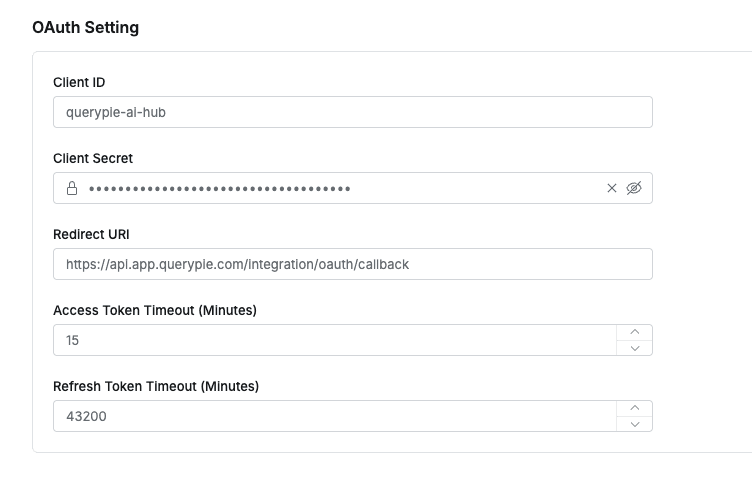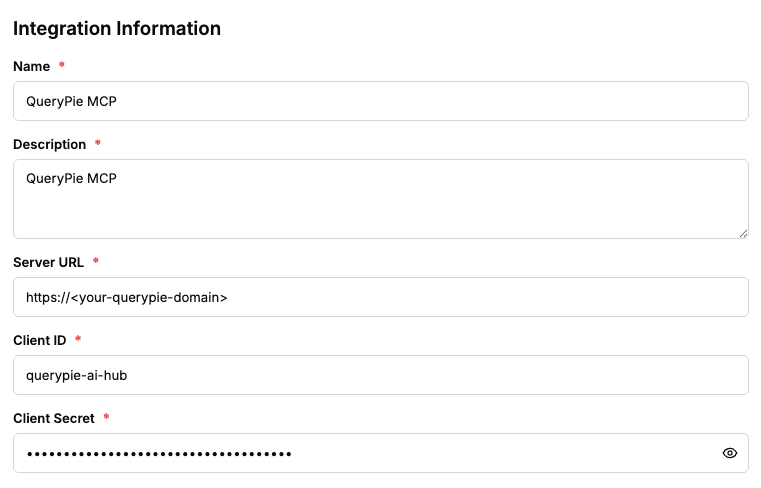QueryPie KAC
Securely access Kubernetes clusters through QueryPie platform’s KAC (Kubernetes Access Control).
Key Features
- Kubernetes cluster access through QueryPie KAC (Kubernetes Access Control)
- Permission-based Kubernetes resource management
- Secure kubectl command execution
Basic Information
Authentication Method
Administrators must set up MCP server configuration in advance. Users authenticate using OAuth.
Input Parameters
- Server URL (Required): QueryPie domain
- Authorization URL for OAuth (Required): OAuth authorization URL
- Token URL for OAuth (Required): OAuth token URL
- Client ID (Required): OAuth client ID
- Client Secret (Required): OAuth client secret
You can find these in QueryPie admin page > General Settings > Security > OAuth Settings.
OAuth Integration Guide
This is the procedure to integrate QueryPie with AIP using OAuth. Please follow the steps below.
-
Access QueryPie and Admin Login
Access your organization’s QueryPie domain (e.g.,https://<your-querypie-domain>) and log in with an administrator account. -
Navigate to OAuth Settings
Go to Admin Page → General Settings → Security → OAuth Settings menu.
-
Copy Client ID and Secret
Enter Client ID and Copy your Client ID and Client Secret. You will need them in step 5 below. -
Enter AIP’s OAuth callback URL
Enterhttps://api.app.querypie.com/integration/oauth/callbackin the Redirect URI field. -
Access AIP and Enter OAuth settings in AIP
Enter the following values in the QueryPie MCP settings in the MCP Integration Management menu of the AIP administrator page:- Server URL: e.g.,
https://<your-querypie-domain> - Client ID (The value you copied in step 3 above)
- Client Secret (The value you copied in step 3 above)

- Server URL: e.g.,
Supported MCP Tools
KAC (Kubernetes Access Control) Tools
Manage Kubernetes cluster access through QueryPie’s Kubernetes access control functionality.
QueryPie KAC MCP only works with Kubernetes clusters managed by QueryPie.
list_accessible_k8s_roles
Retrieve a list of all accessible Kubernetes roles. You must select a role to use in subsequent commands.
list_accessible_k8s_clusters
Retrieve a list of all accessible Kubernetes clusters.
Input Parameters:
roleUuid(Required): Role UUID
list_k8s_namespaces
Retrieve a list of namespaces in the Kubernetes cluster.
Input Parameters:
roleUuid(Required): Role UUIDclusterUuid(Required): Cluster UUID
run_kubectl_command
Execute kubectl commands on the Kubernetes cluster.
Input Parameters:
roleUuid(Required): Role UUIDclusterUuid(Required): Cluster UUIDnamespace(Optional): Namespace (default: default)command(Required): kubectl command to execute
Usage Examples
For example,
- When you input the prompt “Show me the list of Kubernetes clusters accessible through QueryPie”,
- The LLM will sequentially call
list_accessible_k8s_rolesandlist_accessible_k8s_clusterstools through QueryPie KAC MCP, then respond based on the results.
Precautions
- Maintain security through proper permission settings.
- Follow your organization’s security policies when accessing Kubernetes clusters.
- Regularly review access logs.
- Consider the impact on cluster resources when executing kubectl commands.